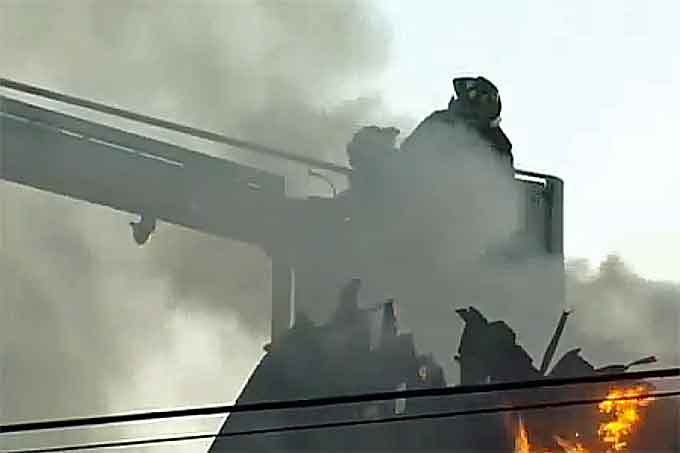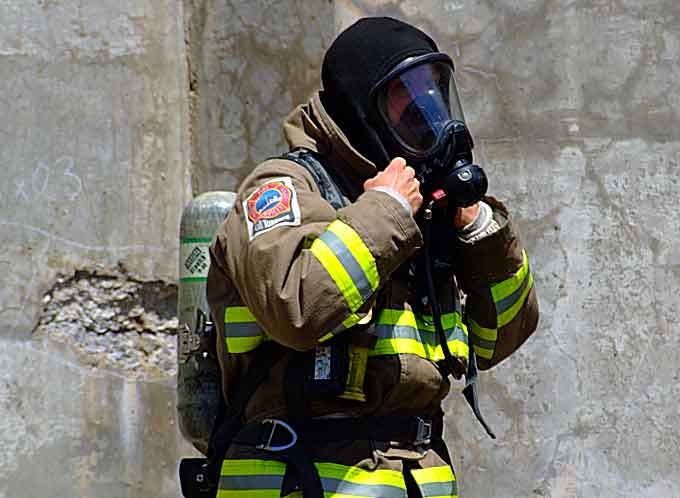
By the U.S. Fire Administration
As a firefighter, you know that firefighting activities can lead to chemical contamination.
But do you know what steps you can take to reduce exposures?
This understanding is critical as different fireground activities have different types and levels of exposure risk.

If your fire department hasn’t already done so, it needs to develop or refine its policies for decontaminating gear and skin after live fire responses to reduce the potential risk of cancer.
In 2014, the largest cohort study to date found an increased mortality and incidence risk for all cancers among firefighters.
A follow-up study one year later found further evidence that points to a causal association between the time directly engaged in live fire assignments and lung cancer and leukemia incidence.
Chemicals formed as byproducts of combustion are thought to be responsible for this elevated risk but the role of contamination on personal protective equipment (PPE) or skin called for more study.
(Learn More. Research has found significantly higher rates of respiratory, digestive and urinary cancers in firefighters than in the general population. Courtesy of CBS News and YouTube. Posted on May 19, 2014)
Study of Polycyclic Aromatic Hydrocarbons and Other Chemicals
A study published in 20171 focused on polycyclic aromatic hydrocarbons (PAHs) for PPE surface and skin testing.
PAHs may go through or around PPE or cross-transfer later from the PPE to the skin during removal.
(Learn More. Fire departments across the country are ordering changes to how they operate in the field, after alarming new research shows that cancer has become the number one killer of firefighters in this country. Courtesy of NBC News and YouTube. Posted on Oct 23, 2017)
This study also looked at volatile organic compounds (VOCs) and hydrocyanide (HCN) which may off-gas from contaminated gear and represent another possible exposure pathway.
In this study, three crews of twelve firefighters completed six fireground job assignments that included inside, outside and overhaul tasks.
Researchers took samples of their PPE and skin exposure pre- and post-fire, as well as post-decontamination.
Here’s what they found:
Research takeaways

- PPE, neck skin, and hand skin were most prone to PAH contamination during firefighting.
- The amount of contamination varied by work assignment.
- Inside Attack and Inside Search experienced the most PPE and skin contamination and hand skin was more contaminated than neck skin.
- Inside Search team had more hand skin contamination. This was possibly due to time spent crawling on contaminated floors. The exposure around gloves was likely aided by sweat or water.
- Outside Vent team had the highest frequency of detectable PAH on their necks. This was possibly due to inconsistent use of hoods by those crews.
- Wearing Nomex hoods, even while working on exterior assignments, was important to reduce neck skin exposure.
- Decontamination using dish soap, water and scrubbing was the most effective method for removing PAH from turnout gear while still in the field.
- It was more effective than dry or air-based decon.

- Infrequent cleaning of firefighter turnout gear allows toxic substances to accumulate.
- Contamination on turnout gear increased with each fire response if not decontaminated.
- This study showed first-ever evidence of the value of cleansing wipes.
- Cleansing wipes removed PAH contamination from neck skin, reducing PAH levels by about 54 percent.
- Not all cleansing wipes are equally effective.
- Firefighters should follow up with more thorough cleansing such as showering or hand washing as soon as practicable after the fire.
- Turnout gear was contaminated with VOCs and HCNs but off-gas levels largely dissipated within 24 minutes.
- Still, firefighters could inhale chemicals in the period immediately following a fire response.
- There are also other off-gassing chemicals not included in this study that could pose a longer term hazard.

- Commercial laundering of PPE per NFPA requirements may still be the most effective cleaning method.
-
Departments might want to consider prioritizing laundering for gear based on a firefighter’s response assignment.
-
Learn More about This Research
This research article is available through The U.S. Fire Administration (USFA) library by contacting netclrc@fema.dhs.gov.
Interested readers may be able to access the article through their local library or through the publishers’ websites.
1 Fent, K., Alexander, M., Roberts, J., Robertson, S., Toennis, C., Sammons, D., Bertke, S., Kerber, S., Smith, D., Horn, G. (2017). Contamination of firefighter personal protective equipment and skin and the effectiveness of decontamination procedures. Journal of Occupational and Environmental Hygiene: Vol 14 (10), 801-814.
More information on cleaning PPE
- PPE use and unsafe actions by firefighters
- Flame-retardant contamination of PPE a potential health risk
- Safety alert: Take care to clean protective hoods
















